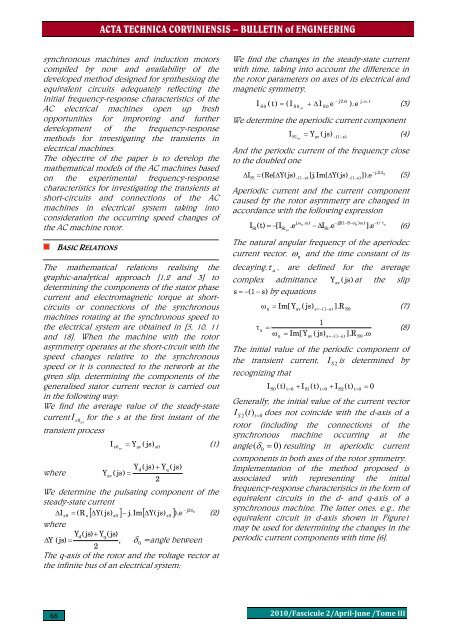ACTA TECHNICA CORVINIENSIS - Bulletin of Engineering
ACTA TECHNICA CORVINIENSIS - Bulletin of Engineering
ACTA TECHNICA CORVINIENSIS - Bulletin of Engineering
- No tags were found...
Create successful ePaper yourself
Turn your PDF publications into a flip-book with our unique Google optimized e-Paper software.
<strong>ACTA</strong> <strong>TECHNICA</strong> <strong>CORVINIENSIS</strong> – BULLETIN <strong>of</strong> ENGINEERINGsynchronous machines and induction motorscompiled by now and availability <strong>of</strong> thedeveloped method designed for synthesising theequivalent circuits adequately reflecting theinitial frequency-response characteristics <strong>of</strong> theAC electrical machines open up freshopportunities for improving and furtherdevelopment <strong>of</strong> the frequency-responsemethods for investigating the transients inelectrical machines.The objective <strong>of</strong> the paper is to develop themathematical models <strong>of</strong> the AC machines basedon the experimental frequency-responsecharacteristics for investigating the transients atshort-circuits and connections <strong>of</strong> the ACmachines in electrical system taking intoconsideration the occurring speed changes <strong>of</strong>the AC machine rotor.BASIC RELATIONSThe mathematical relations realising thegraphic-analytical approach [1,2 and 3] todetermining the components <strong>of</strong> the stator phasecurrent and electromagnetic torque at shortcircuitsor connections <strong>of</strong> the synchronousmachines rotating at the synchronous speed tothe electrical system are obtained in [5, 10, 11and 18]. When the machine with the rotorasymmetry operates at the short-circuit with thespeed changes relative to the synchronousspeed or it is connected to the network at thegiven slip, determining the components <strong>of</strong> thegeneralised stator current vector is carried outin the following way:We find the average value <strong>of</strong> the steady-statecurrent I sfor the s at the first instant <strong>of</strong> the0 avtransient processI = Y (js(1)avwhereYavs 0 av)s0Yd(js) + Yq(js)(js) =2We determine the pulsating component <strong>of</strong> thesteady-state current− j2δ0Δ Is0= (Re[ ΔY(js)s0] − j.Im[ ΔY(js)s0]).e (2)whereYd (js) + Yq(js)Δ Y (js) =, δ0=angle between2The q-axis <strong>of</strong> the rotor and the voltage vector atthe infinite bus <strong>of</strong> an electrical system;We find the changes in the steady-state currentwith time, taking into account the difference inthe rotor parameters on axes <strong>of</strong> its electrical andmagnetic symmetry,IS 0(t)− j2 st j. ω.t= (IS 0+ ΔIS 0e ). e(3)avWe determine the aperiodic current componentIS 1 avYav(js)−(1−s)= (4)And the periodic current <strong>of</strong> the frequency closeto the doubled one− j.2. δ0Δ IS1= (Re[ ΔY(js)−(1−s)]j.Im[ ΔY(js)−(1−s)]). e (5)Aperiodic current and the current componentcaused by the rotor asymmetry are changed inaccordance with the following expressionIS1(t)j. ωn. ω.t−j2(1−S−ωn ) ω.t−t / τa= −[IS1.e −ΔIavS1.e]. e (6)The natural angular frequency <strong>of</strong> the aperiodeccurrent vector, ω and the time constant <strong>of</strong> itsndecaying, τa, are defined for the averagecomplex admittance Y av(js) at the slips = −(1− s) by equationsω = Im[ Y (js) ]. R(7)navs=−(1−s)1τa=(8)ω = Im[Y (js) ].R ωnavS0s= −(1−s)S0.The initial value <strong>of</strong> the periodic component <strong>of</strong>the transient current, is determined byrecognizing thatI S 2I0(t)t=0+ IS1(t)t=0+ IS2(t)t=0S=Generally, the initial value <strong>of</strong> the current vectorI St does not coincide with the d-axis <strong>of</strong> a2( )t=0rotor (including the connections <strong>of</strong> thesynchronous machine occurring at theangle ( δ 0= 0)resulting in aperiodic currentcomponents in both axes <strong>of</strong> the rotor symmetry.Implementation <strong>of</strong> the method proposed isassociated with representing the initialfrequency-response characteristics in the form <strong>of</strong>equivalent circuits in the d- and q-axis <strong>of</strong> asynchronous machine. The latter ones, e.g., theequivalent circuit in d-axis shown in Figure1may be used for determining the changes in theperiodic current components with time [6].0682010/Fascicule 2/AprilJune /Tome III
















